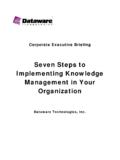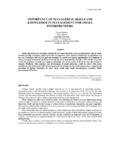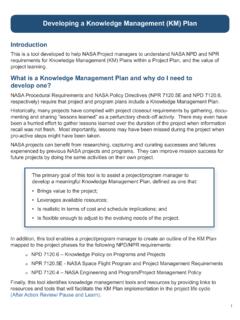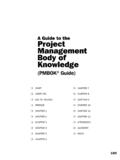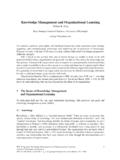Transcription of Techniques for Effective Knowledge Management
1 ATP (FM ) Techniques for Effective Knowledge Management DISTRIBUTION RESTRICTION. Approved for public release; distribution is unlimited. Headquarters Department of the Army MARCH 2015 This publication is available at Army Knowledge Online ( ). To receive publishing updates, please subscribe at *ATP (FM )ATP No. 6- Headquarters Department of the Army Washington, DC, 6 March 2015 Techniques for Effective Knowledge Management Contents Page v INTRODUCTION .. vi Chapter 1 Knowledge Management SUPPORT TO THE ARMY .. 1-1 Knowledge Management .
2 1-1 Enable the Mission Command Warfighting Function .. 1-5 Organizing the Mission Command System .. 1-8 Enabling the Operations Process .. 1-9 Creating a Knowledge -Sharing Environment .. 1- 11 Chapter 2 ASSESSING Knowledge Management .. 2-1 Assessment .. 2-1 Knowledge Management Assessment Overview .. 2-1 Performing the Knowledge Management Assessment .. 2-3 Assessment Outcome and Recommendations .. 2- 13 Focus Areas for Assessment .. 2- 14 Scenario Illustrating Assessment .. 2- 14 Chapter 3 DESIGNING Knowledge Management SOLUTIONS.
3 3-1 Design Overview .. 3-1 Solution Design For Common Problem Areas .. 3-4 Scenario Illustrating Design Solutions .. 3- 13 Chapter 4 DEVELOPING Knowledge Management SOLUTIONS .. 4-1 Overview .. 4-1 Developing Solutions .. 4-1 Scenario Illustrating Solution 4-2 Chapter 5 PILOTING Knowledge Management SOLUTIONS .. 5-1 Piloting Overview .. 5-1 Knowledge Management Piloting Techniques .. 5-1 Distribution Restriction: Approved for public release; distribution is unlimited. *This publication supersedes FM , dated 16 July March 2015iContents Chapter 6 IMPLEMENTING Knowledge Management SOLUTIONS.
4 6-1 Implementation OvervIew .. 6-1 Implementation Steps .. 6-1 Implementation Plan .. 6-2 Documenting Solutions During Implementation .. 6-3 Implementation to Assessment .. 6-4 Appendix A Knowledge Management ANNEX FORMAT FOR AN OPERATIONS ORDER .. A-1 Appendix B Knowledge Management STANDARD OPERATING PROCEDURES .. B-1 Standard Operating Procedures Development .. B-1 Appendix C Knowledge Management TOOLS .. C-1 Knowledge Management Tools Selection .. C-1 Non-Digital Knowledge Management Tools .. C-1 Digital Knowledge Management Tools.
5 C-2 Mission Command Information Systems and Collaboration Tools .. C-3 Appendix D CONTENT Management .. D-1 Content Management Tasks .. D-1 Content Management Common Phrases .. D-3 Content Management Principles .. D-3 Content Management Techniques .. D-5 Appendix E INTERVIEWING Techniques FOR Knowledge Management ASSESSMENTS .. E-1 Purpose .. E-1 Role of the Interviewer .. E-1 Prepare for the Interview .. E-2 The Interview .. E-2 Appendix F FACILITATING A PROFESSIONAL FORUM .. F-1 Army Professional Forums .. F-1 Appendix G FOCUS AREAS FOR Knowledge Management ASSESSMENT.
6 G-1 Standards Analysis .. G-1 Time Management .. G-1 Meeting Analysis .. G-2 Report Analysis .. G-5 Technical Systems Analysis .. G-5 Content Management Analysis .. G-6 Appendix H Knowledge Management STRATEGY FORMAT (EXAMPLE) .. H-1 GLOSSARY .. Glossary-1 REFERENCES .. References-1 INDEX .. Index-1 Figures Figure 1-1. Knowledge Management an iterative cycle .. 1-1 ii ATP 6 March 2015 Contents Figure 1-2. Flattening organizational staff processes .. 1- 12 Figure 2- 1. Example of Knowledge Management priorities chart.
7 2-9 Figure 2-2. Example of a concept map .. 2- 12 Figure 2-3. A way to convey key Knowledge Management mapping information .. 2- 13 Figure 4-1. Information system interface .. 4- 13 Figure 4-2. Flattening the network .. 4- 14 Figure 4-3. Company Intelligence Support Team (CoIST) collaboration .. 4- 14 Figure 6-1. Knowledge Management process cycle .. 6-4 Figure C-1. Examples of Army professional forums .. C-2 Figure G-1. Example battle rhythm analysis .. G-2 Tables Table 1-1. The Knowledge Management process .. 1-2 Table 1-2. Inputs and outputs.
8 1-2 Table 1-3. How Knowledge Management enhances decisionmaking .. 1-6 Table 2-1. Steps of assess key inputs and outputs .. 2-3 Table 2-2. A simple tool for collecting people, processes, tools, and organization 2-5 Table 2-3. Gap analysis chart .. 2-8 Table 2-4. Completed gap analysis chart for the initial assessment .. 2- 17 Table 2-5. Completed gap analysis chart for the follow up assessment .. 2- 19 Table 3-1. Steps of design - key inputs and outputs .. 3-3 Table 3-2. Example meeting agenda quad chart .. 3-6 Table 3-3. Example significant activities initial report.
9 3-7 Table 3-4. Example of file naming convention (update graphic dates) .. 3- 10 Table 4-1. Steps of develop key inputs and outputs .. 4-2 Table 4-2. Balancing the digital and analog components in the brigade combat 4-6 Table 4-3. Current division reports and proposed changes .. 4- 15 Table 5-1. Pilot steps and key inputs and 5-2 Table 5-2. Assessment measures and variables .. 5-3 Table 6-1. Implement .. 6-2 Table 6-2. Gaps to solutions tracker .. 6-3 Table D-1. Content Management table .. D-2 Table D-2. Content Management Techniques for individuals.
10 D-5 Table D-3. Content Management Techniques for teams .. D-6 Table D-4. Content Management Techniques for organizations .. D-6 Table E-1. Example interview questions ..E-2 Table E-2. Things to avoid when interviewing ..E-2 Table E-3. Tips for a successful interview ..E-3 Table F-1. Daily tasks .. F-3 Table F-2. Weekly tasks .. F-4 6 March 2015 ATP iii Contents Table F-3. Monthly tasks .. F-4 Table F-4. Quarterly F-4 Table F-5. Performance metrics .. F-5 Table G-1. Example working group agenda .. G-4 iv ATP 6 March 2015 Preface Publication ATP provides doctrinal Knowledge Management guidance.










